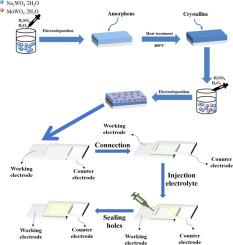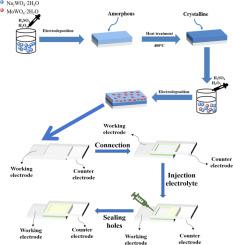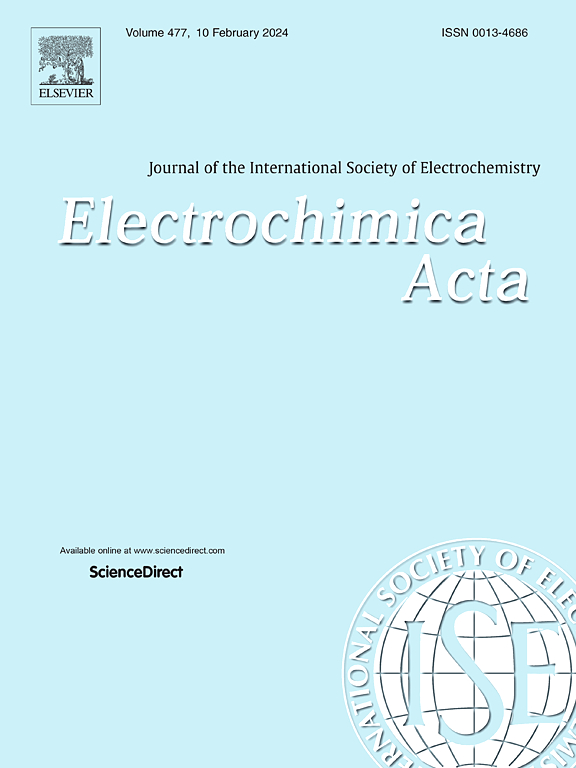Optimization of electrochromic Mo doping WO3 films: A study on dual-phase stacked structures for energy-efficient smart windows
IF 5.5
3区 材料科学
Q1 ELECTROCHEMISTRY
引用次数: 0
Abstract
Amorphous tungsten trioxide (a-WO3) films were prepared on ITO conductive glass via electrodeposition and subsequently crystallized to obtain crystalline WO3 (c-WO3) films by heating a-WO3. A dual-phase stacked WO3 film was fabricated by covering Mo-a-WO3 film onto c-WO3/ITO substrate using electrodeposition and thermal-assisted electrodeposition methods, respectively. Optimization of electrochromic performance was achieved by varying Mo doping levels (0∼5 atom%). Results demonstrate that appropriate Mo doping (3 atom%) enhances the electrochromic properties of a-WO3 films. Mo doping introduced structural distortions that reduced energy barriers and enhanced ion mobility, leading to improved electrochemical and electrochromic properties. The intermediate c-WO3 layer improves adhesion between a-WO3 top film and ITO glass substrate, while the porous structure of a-WO3 layer increases the number of active sites for electrochromic reactions. Mo3-a-WO3/c-WO3 dual-phase stacked film with doping 3 atom% Mo shows an optical modulation range of 83.4 % at 633 nm, a coloration efficiency of 74.3 cm2/C, rapid response time (bleaching/coloration: 3.4 s/6.1 s), and 86.6 % retention of its maximum current density after 2000 cycles, respectively. The high oxidation ion diffusion coefficient (3.53 × 10−10 cm2/s) and reduction diffusion coefficient (1.55 × 10−10 cm2/s) were also observed. This dual-phase stacked film shows significant improvements in electrochromic performance due to the synergistic effects between the dual phases and Mo-doping. Electrochromic device (ECD) assembled with Mo3-a-WO3/c-WO3 dual-phase films as the working electrode, ITO glass as the counter electrode, and 1 mol/L LiClO4/PC solution as the electrolyte exhibited an optical modulation range of 74.2 % and response time (bleaching/ coloring) of 6.8 s/3.7 s. These findings confirm that ECD with Mo-a-WO3/c-WO3 dual-phase films offer excellent electrochromic performance.


电致变色钼掺杂 WO₃ 薄膜的优化:用于高能效智能窗户的双相叠层结构研究
通过电沉积法在 ITO 导电玻璃上制备了无定形三氧化钨(a-WO3)薄膜,随后通过加热 a-WO3 结晶得到了晶体 WO3(c-WO3)薄膜。采用电沉积法和热辅助电沉积法,分别将 Mo-a-WO3 薄膜覆盖在 c-WO3/ITO 基底上,制备出了双相叠层 WO3 薄膜。通过改变钼的掺杂水平(0∼5atom%)实现了电致变色性能的优化。结果表明,适当的钼掺杂(3atom%)可增强 a-WO3 薄膜的电致变色性能。钼掺杂引入了结构畸变,从而降低了能障并提高了离子迁移率,从而改善了电化学和电致变色特性。中间的 c-WO3 层提高了 a-WO3 表层薄膜与 ITO 玻璃基底之间的附着力,而 a-WO3 层的多孔结构则增加了电致变色反应的活性位点数量。掺杂了 3 原子%钼的 Mo3-a-WO3/c-WO3 双相叠层薄膜在 633 纳米波长下的光学调制范围为 83.4%,着色效率为 74.3 cm²/C,响应时间快(漂白/着色:3.4 秒/6.1 秒),循环 2,000 次后最大电流密度的保持率为 86.6%。氧化离子扩散系数(3.53 × 10-¹⁰ cm²/s)和还原离子扩散系数(1.55 × 10-¹⁰ cm²/s)也很高。由于双相和掺杂钼之间的协同效应,这种双相叠层薄膜的电致变色性能有了显著提高。以 Mo3-a-WO3/c-WO3 双相薄膜为工作电极、ITO 玻璃为对电极、1 mol/L LiClO4/PC 溶液为电解液组装的电致变色器件(ECD)的光学调制范围为 74.2%,响应时间(漂白/着色)为 6.8 秒/3.7 秒。
本文章由计算机程序翻译,如有差异,请以英文原文为准。
求助全文
约1分钟内获得全文
求助全文
来源期刊

Electrochimica Acta
工程技术-电化学
CiteScore
11.30
自引率
6.10%
发文量
1634
审稿时长
41 days
期刊介绍:
Electrochimica Acta is an international journal. It is intended for the publication of both original work and reviews in the field of electrochemistry. Electrochemistry should be interpreted to mean any of the research fields covered by the Divisions of the International Society of Electrochemistry listed below, as well as emerging scientific domains covered by ISE New Topics Committee.
 求助内容:
求助内容: 应助结果提醒方式:
应助结果提醒方式:


